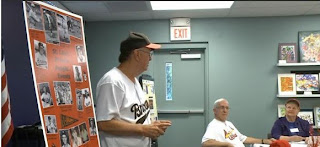Thursday, July 25, 2013
Eddie Gaedel's bat, used in MLB's most famous stunt, readies for sale at Heritage Auctions
It was the bottom of the first inning of the second game of a doubleheader and Gaedel took four straight balls and headed to first base and into baseball history.
On Aug. 1, as part of Heritage Auctions' Platinum Night Sports Auction in Rosemont, IL, taking place in conjunction with The National Sports Collector's Convention, the bat that sat perched atop Gaedel's shoulder for those four pitches will appear for the very first time at auction. It is expected to bring $100,000+.
"Veeck was behind some of the most famous, and infamous, ballpark stunts in the history of America's pastime," said Chris Ivy, Director of Sports at Heritage Auctions, "including Cleveland Municpal Stadium's disastrous 10 cent beer night in 1974. It was his 1951 stunt with Gaedel as the smallest batter in league history, however, that he is most remembered for."
The bat has been consigned to auction by Gaedel's nephew, Bob Gaedele, a Chicago-area resident who was given the bat by his father when he was around 10 years old. Bob's father, Eddie's younger brother, received the bat from Eddie after the game.
Read the rest of the story at: http://www.artdaily.org/index.asp?int_sec=11&int_new=63956#.UfFA-I0o7oo
Wednesday, July 24, 2013
Browns Fan Club Participates in Cardinals Reminisence League
By Art Holliday
ST. LOUIS (KSDK) - When a group
of St. Louis Cardinals fans get together, the conversation is easy because they
have shared memories. That's the idea behind the Cardinals Reminiscence League:
sharing memories to preserve memories. Their guest speaker this month was Bill
Rogers, President of the St. Louis Browns Fan Club. "While the Browns have
been gone a long time, this group remembered quite a bit about the Browns
players," according to Rogers. "The Browns Historical Society is
pleased to offer support and participate in their programs."
Just like a baseball game, the Cardinals Reminiscence
League begins with the national anthem. A difficult song is even more of a
challenge for people with Alzheimer's; not everyone remembers the words. Twice
a month at the Alzheimer's Association office, the Cardinals Reminiscence
League meets. The participants have two things in common: love of baseball and
early stage Alzheimer's disease. The program is inspired by a dementia support
group in Scotland. Reminiscence therapy has several benefits. It improves memory
and mood. It improves communication. And it gives the league participants a purpose,
gathering every other week to talk about baseball memories.
Jim Muskopf is a regular at the twice monthly
meetings.
"I have to be active. My lifestyle is been
that way so many years," he said
.
The 69-year-old Muskopf was the director of
graduate studies at Fontbonne University until retiring in 2011. He and his
wife Ruth realized things were not right. It wasn't a total surprise that
Muskopf has Alzheimer's because his mother had it.
"He knows he's got the disease," said
Ruth Muskopf about her husband. "And he knows from his experience with his
mother what's possible down the road. But being here and sharing with the other
people it's like everybody's normal. They're all talking and doing the same
thing and you forget about the Alzheimer's."
"It really is a very good way to trigger
remembering and get people talking about something that they can all mutually
remember," said Morley. "In St. Louis, the Cardinals belong to
everyone. It makes people happy, not only the participants, but the caregivers,
who get to see a loved one really excited about something."
Click the link below to view Art Holliday's report.
To participate or volunteer for the Cardinals
Reminiscence League visit www.alz.org/stl.
Major League Baseball Relocation of the 1950s - 1960s
Major League Baseball
- 1902: Milwaukee Brewers moved to St. Louis, Missouri and became the St. Louis Browns.
- 1903: Baltimore Orioles moved to New York and became the Highlanders. The team was
renamed the Yankees in 1913.
- 1953: Boston Braves
moved to Milwaukee. This was the first
relocation in 50 years. During those 50 years, there had also been no
expansions or contractions—Major League Baseball had consisted of the same
16 teams, 8 in each league, playing in the same 10 cities without
interruption for half a century.
- 1954: St. Louis Browns moved
to Baltimore and became the Orioles.
- 1955: Philadelphia
Athletics moved to Kansas City,
Missouri.
- 1958: Brooklyn Dodgers
moved to Los Angeles; New York
Giants moved to San Francisco. These were the first major
league teams on the West Coast; the teams moved simultaneously to
facilitate travel for other National League (NL) teams.
- 1961: Washington Senators
(original) moved to the Twin Cities area and
became the Minnesota Twins. Not
wishing to alienate Washington, D.C. and its
powerful baseball fans, the American League (AL) granted the city a new
expansion franchise, also called the Senators.
- 1966: Milwaukee Braves moved
to Atlanta, Georgia.
- 1968: Kansas City
Athletics moved to Oakland, California. Because Charles O. Finley broke a recently signed lease
and public bonds were already issued for the building of what is now known
as Kauffman Stadium, Major League Baseball was in danger of anti-trust legislation from Missouri Senator Stuart Symington. As a result, the AL granted
Kansas City a new expansion franchise
in 1969.
- 1970: Seattle Pilots moved to Milwaukee and became
the Brewers. The AL would grant
Seattle a new expansion franchise in 1977.
- 1972: Second Washington
Senators moved to Arlington, Texas and became the Texas Rangers.
- 2005: Montreal Expos moved to Washington, D.C. and became the Washington Nationals. The Expos had split time between Montreal and San Juan, Puerto Rico in 2003 and 2004. This was the first relocation in 33 years.
Subscribe to:
Comments (Atom)


